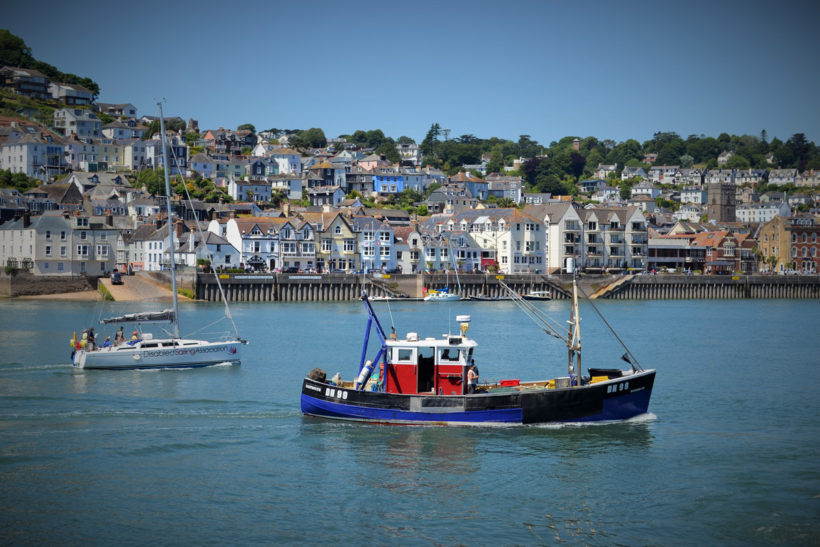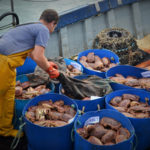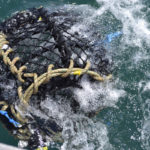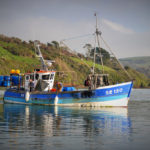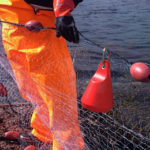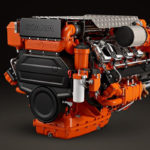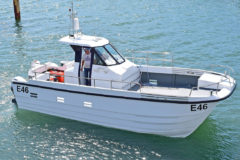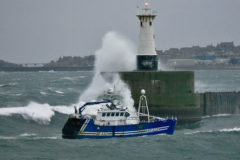Co-management is a current buzz-word – but on the Devon coast, it’s nothing new. The South Devon Inshore Potting Agreement is a longstanding exemplar of what can be achieved by fishermen working together, reports Holly Kaiser
The south coast of Devon is famed for its glorious beaches, picturesque harbours, buzzing fishmarkets and tasty crab sandwiches. My own reminiscences of holidays in the south of England inspire a sense of gratitude for the communities at the heart of this coastal cultural heritage. Wandering into any of the numerous seafood restaurants along the coast, one is struck by the diversity of seafood on offer, presented in all manner of innovative ways.
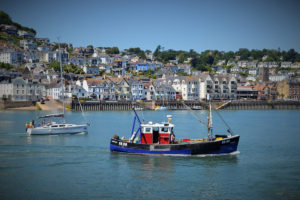
01 The South Devon IPA pioneered a voluntary management system which allocated sea areas off Salcombe estuary for different fishing activities. (Photos: South Devon & Channel Shellfishermen Ltd)
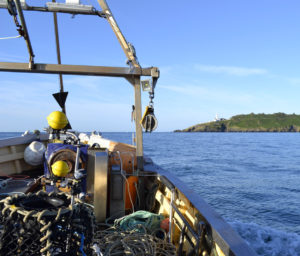
06 Fisherman Paul Dornom: “There is good compliance because there’s a feeling that everyone wants a future for the IPA.”
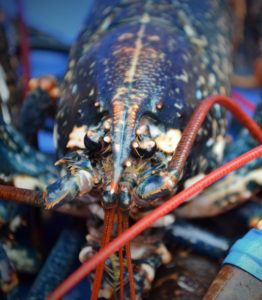
05 The IPA has helped to foster a sense of custodianship of the resource, which is reflected in the catch quality.
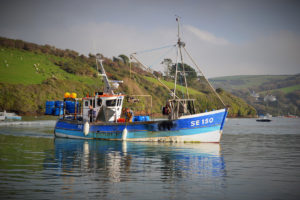
04 Zonal and temporal management foster a harmonious working environment for boats like the Salcombe potter Claire Louise.
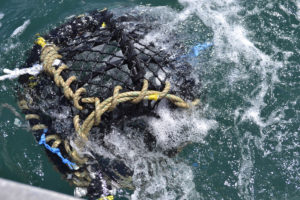
03 Prior to the agreement, many static-gear fishermen experienced huge financial losses from towed or damaged gear.
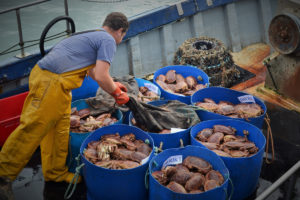
02 Static-gear-only zones allow potters like the Salcombe vessel Davrik to keep their gear on the same ground for most of the year.
That innovation runs far deeper than just culinary ventures. Supporting the coastal towns are fishing communities bound together by an industry-driven management system that has proved successful in so many ways. Where once there was conflict, there is now well-established collaboration within the industry and with scientists, government bodies and other stakeholders.
Today’s crab and lobster fishermen in South Devon have previous generations to thank for having the vision to join together in the late 1960s to create South Devon Shellfishermen Ltd, the predecessor of South Devon & Channel Shellfishermen Ltd (SD&CS). The association is made up of fishing industry professionals including fishermen, merchants, processors and gear suppliers, many of whom can trace back a family lineage of shellfishermen at least three or four generations. Speaking to the members immediately gives a sense of their feeling of duty to protect the resource upon which past, present and future generations depend.
The association, working with other sectors, initiated a pioneering voluntary management system in 1978, which allocated different sea areas off Salcombe estuary for different fishing activities. This management system has evolved continuously through a process of annual negotiation involving different fishing sectors, developing zonal and temporal management. Today, this management system is still known as the Inshore Potting Agreement (IPA).
The IPA was developed by SD&CS as a response to the growing conflict for space among different industry sectors. The solution embodied in the IPA set out zoned exclusive or shared access for different fishing activities, allowing fishermen using static gear to fish in areas they knew to be designated specifically for this activity.
The agreement – initially a gentlemen’s agreement – was largely effective, but was put under strain in the late 1990s when an increasing number of fishers moved from the whitefish sector into the scallop fleet. Eventually the IPA was formalised by regulation in 2002, after which abiding by it became a condition of fishing vessel licences. It has remained an exemplar of industry collaboration and management to this day.
Paul Dornom, an active fisherman who has spent most of his career in the IPA, commented on the benefits of seasonal areas, saying that they create ‘less conflict between fishermen and ensure all businesses have the potential to thrive’. The fact that the shared areas exist with reduced conflict highlights the success of co-management between different sectors of fishermen and management authorities, which undoubtedly contributes to the future viability of crab, lobster and scallop populations in the immediate area.
Emphasising that sustainability is at the heart of the community, Paul suggested that ‘there is good compliance because there’s a feeling that everyone wants a future for the IPA’, which has perhaps allowed the necessary compromises to be made by both fishing sectors.
Prior to the agreement, many static-gear fishermen experienced huge financial costs due to lost gear that was towed away or damaged. That situation seems like a distant memory, according to the fishermen, and a far brighter picture is painted today, with much lower levels of conflict due to clearly marked exclusive or seasonal zones serving the needs of trawlers and potters alike.
The IPA has also been successful in creating a responsibility for nomadic or visiting fishermen to increase their awareness of the restrictions – which are detailed in a vessel’s licence to fish – or else be held liable for non-compliance. Whilst legal systems and other technological advances, such as compulsory vessel monitoring systems on mobile-gear vessels, have substantially helped to create a peaceful fishing industry in South Devon, it is the community’s attitude, as reflected in Paul Dornom’s comments, that has proved integral to the successful management system.
Static-gear-only zones allow potters to keep their gear on the same ground for most of the year, and creates the sense that fishermen have custodianship of the resource. Although they do not have exclusive rights, this sense of ownership has strengthened their desire to ensure that stocks are sustainable for the next year of business. The desire to keep the fishery alive for years to come is also reflected in the industry’s willingness to give up time to collaborate with scientists – with the knowledge that the benefits of such research will return to them.
The importance of catch quality was discussed in my conversation with Phil Cardew, who has been actively fishing in the IPA for 25 years. He said: “The stewardship we have is reflected in the way we treat the resource. We ensure that we don’t damage crabs, with measures such as escape gaps in pots, which allow juveniles to easily exit.” He spoke about how most of the industry have supported other important initiatives such as increasing the minimum landing size for crab.
The attitudes reflected in the comments and actions of fishermen like Paul Dornom and Phil Cardew are quintessential for successful co-management, and evidently it is very effective at the industry level.
So what are the features that help this South Devon association work so effectively? The SD&CS provides a platform for member fishermen to express their opinions openly within a close community where there is respect for different fishermen’s interests, opinions and knowledge. Consolidating this type of co-management approach has the potential to solve a range of problems caused by gaps in information, where the practicalities of fishing are often misunderstood. Likewise, the pragmatism behind certain regulations often becomes confused amongst the jargon, and fails to resonate with fishermen who haven’t had a say in their implementation.
A next step in expanding upon such an encouraging example would be to replicate this model of management in other areas of the UK. Inclusion and collaboration between management organisations, such as that in evidence between the SD&CS, the IFCA and the MMO, would enable further integration of management bodies and allow more trust to be built up between fishermen and those who impose measures on them.
If sceptics doubt the capability of the fishing industry to manage its own affairs in a responsible manner, the proactive interventions made by the industry to maintain the high quality of seafood landed within South Devon fisheries should surely inspire confidence in trusting fishermen with responsibility to co-manage the resource. The values expressed by members of the SD&CS confirm that environmental sustainability, their businesses and the wider community are at the heart of the fishermen’s day to day lives.
The ongoing story of the IPA serves as a model for other fishing communities looking to collectively create a thriving industry and harmonious way of living, integrating management bodies, industry stakeholders and those with conservation interests to develop a successful co-management system that rewards the values of culture, history and sustainable livelihoods.
While there are many other successful local fisheries in the UK, one wonders whether some of the lessons learned in South Devon could be duplicated elsewhere around the country where success is less evident.
Innovative solution to lost gear problems
The fishing industry is set to welcome a new product on the market that promises an end to both the financial and environmental impacts for fishermen who lose their pots, gill-nets and even trawls.
As well as the major financial loss for a skipper who loses his gear, due to storms or it being dragged away by another vessel, the environmental impacts of lost gear ‘ghost fishing’ has for many years been highlighted for the huge damage to fish stocks it can cause. Every year, 640,000t of fishing gear is lost globally, and 33% of all plastic litter in the ocean comes from the fishing industry.

07 The PingMe sensor device.
The simplest ideas are always the best, and when Norway-based Ocean Space Acoustics (OSAC) set about finding a solution, it collaborated with SINTEF, Norway’s largest research institute, to work not just towards achieving cleaner oceans but also to help fishermen avoid potential costly losses.
This collaboration has resulted in the patented ‘PingMe’ – a smart tool for tagging gear and objects underwater which, with new transponder technology either integrated with the boat’s sonar or as a stand-alone (‘plug and play’) system, makes it easy to find and identify lost gear.
Now reaching the latter stages of development, PingMe will initially be on the market as an affordable stand-alone system – a sensor and a wheelhouse-based signal reader – but work is already underway to provide a system that will allow for simple integration of the signal reader into any vessel’s existing sounder.
PingMe consists of a small, user-friendly sensor device or ‘egg’ which is attached to the gear before shooting. With a software module integrated into the boat’s sounder system, or as a stand-alone system, this device acts as a locator and location monitoring system.
The PingMe software allows communication with the transponder to determine location and ID. As an added bonus, the PingMe service also reports location and ID to the ‘cloud’, where the information is stored. Data on lost, detected and retrieved gear is also reported to the cloud, some of it automatically.
This not only enables the fisherman to monitor the location of his gear but could, depending on how many fishermen are using the information available, help avoid conflicts with other boats or fisheries, which can use the system to ‘see’ where gears are working.
The transponder itself is passive and reflects the soundwaves originating from the sonar – to a range of 1,000m. The reflected signal is encoded with a unique identity, so that the sounder with PingMe software integrated can identity the transponder and calculate its position. This information can be encrypted if the information is to be transferred to the cloud. And, with PingMe’s scheduled online service, you can register your own lost gear with associated ID, or report findings of other lost gears.
An added bonus of this new product is that the PingMe sensor also relays information on water temperature at its location – knowledge that can greatly benefit fishermen when choosing the site for shooting their gear.
PingMe can also be used for better control during active fishing. By attaching transponders at regular intervals to the gear, improved control of where the gear is currently located can make fishing more efficient and profitable.
Comments from fishermen in Norway suggest a very positive reaction to the PingMe system. On the west coast of Ireland, where harsh sea conditions are common, several lobster and crab pot fishermen are excited at the concept.
“When my gear has been out for several days during stormy conditions, my only thought as I go to sea is: ‘I wonder how many leaders of pots/traps I will have lost this time?’” one fisherman said.
“Before even leaving my home, knowing that my gear is still where I left it, or at least if it has moved, that I will have the ability to go and find it, would give me fantastic peace of mind,” he said, adding that a tool such as this, which will reduce the major costs that fishermen face in replacing lost gear, will be a ‘game changer’ for the industry.
Find out more at: osac.no/english
Scania Engines becomes Scania Power Solutions
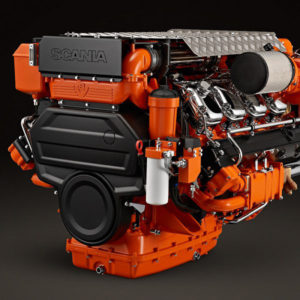
08 Hybrid Scania engines will soon be introduced for marine applications.
Scania Engines has been rebranded as Scania Power Solutions. This, the company says, is in order to reflect the widening range of power options Scania offers, with new types of motive power including electric motors and e-machines (electric motors plus their associated adjacent hardware) soon coming to the fore.
“We are now rapidly approaching the point where the advances we have made in electrification will be shared with our engine customers,” said David Bamber, head of power solutions for Scania (Great Britain) Ltd. “For example, the coming years will see new products such as hybrid Scania engines introduced for marine, industrial and power-generation applications as we progressively move toward full electrification. The Scania Power Solutions branding has been created to encompass this widening of our product portfolio and the extensive range of applications we cover.”
Scania’s power solutions have long been employed by customers in the UK, says the company, and global sales of its power solutions in 2020 amounted to 10,500 units. Today, its engines can be found in a wide variety of applications, with typical marine applications including high-speed patrol boats, ferries, workboats and fishing vessels.
Find out more about Scania Power Solutions at: bit.ly/37Gvu7X



